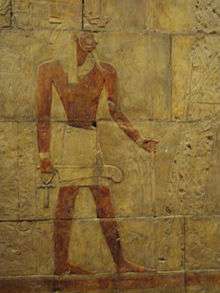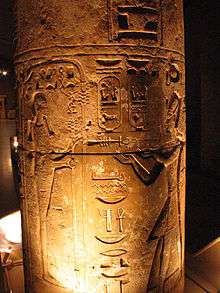Ankh
_01.svg.png)
The ankh (/ˈæŋk/ or /ˈɑːŋk/; Egyptian ꜥnḫ), also known as crux ansata (the Latin for "cross with a handle") is an ancient Egyptian hieroglyphic ideograph with the meaning "life".
The Egyptian gods are often portrayed carrying it by its loop, or bearing one in each hand, arms crossed over their chest. The ankh appears in hand or in proximity of almost every deity in the Egyptian pantheon (including Pharaohs).
The ankh symbol was so prevalent that it has been found in digs as far as Mesopotamia and Persia, and even on the seal of the biblical king Hezekiah.[1]
The symbol became popular in New Age mysticism in the 1960s.
Unicode has two characters encoding the symbol, U+2625 ☥ in the Miscellaneous Symbols block and U+132F9 𓋹 in the Egyptian Hieroglyphs block.
Origin
| Ankh in hieroglyphs | |||||||||
|

Alan Gardiner (1957) explains the hieroglyph as a depiction of a sandal-strap (ꜥnḫ) which came to be read phonetically and could be used (as "rebus writing") for the homophone ꜥnḫ "live".[3]
There have been alternative suggestions. One of the earliest proposals was that of Thomas Inman, first published in 1869, according to which the symbol combines "the male triad and the female unit".[4] E. A. Wallis Budge (1904) postulated that the symbol originated as the belt buckle of the mother goddess Isis,[5]

More recently, the authors of The Quick and the Dead (2004) speculated that the ankh, djed, and was symbols have a basis in "cattle culture", with the ankh representing the thoracic vertebra of a bull (seen in cross section), the djed the base on sacrum of a bull's spine and the was a staff.[6]
History
The ankh appears frequently in Egyptian tomb paintings and other art, often at the fingertips of a god or goddess in images that represent the deities of the afterlife conferring the gift of life on the dead person's mummy; this is thought to symbolize the act of conception. Additionally, an ankh was often carried by Egyptians as an amulet, either alone, or in connection with two other hieroglyphs that mean "strength" and "health" (see explication of djed and was, above). Mirrors of beaten metal were also often made in the shape of an ankh, either for decorative reasons or to symbolize a perceived view into another world.
A symbol similar to the ankh appears frequently in Minoan and Mycenaean sites. This is a combination of the sacral knot (symbol of holiness) with the double-edged axe (symbol of matriarchy)[7] but it can be better compared with the Egyptian tyet which is similar. This symbol can be recognized on the two famous figurines of the chthonian Snake Goddess discovered in the palace of Knossos. Both snake goddesses have a knot with a projecting loop cord between their breasts.[8] In the Linear B (Mycenean Greek) script, ankh is the phonetic sign za.[9]
The ankh also appeared frequently in coins from ancient Cyprus and Asia Minor (particularly the city of Mallus in Cilicia).[10] In some cases, especially with the early coinage of King Euelthon of Salamis, the letter ku, from the Cypriot syllabary, appeared within the circle ankh, representing Ku(prion) (Cypriots). To this day, the ankh is also used to represent the planet Venus (the namesake of which, the goddess Venus or Aphrodite, was chiefly worshipped on the island) and the metal copper (the heavy mining of which gave Cyprus its name).[11]
Coptic Christians preserved the shape of the ankh by sometimes representing the Christian cross with a circle in place of the upper bar. This is known as the Coptic ankh or crux ansata.[12][13]
References
Notes
- ↑ "King Hezekiah in the Bible: Royal Seal of Hezekiah Comes to Light". Biblical Archaeology Society.
- ↑ Collier, Mark and Manley, Bill. How to Read Egyptian Hieroglyphs: Revised Edition pg 23. Berkeley: University of California Press, 1998.
- ↑ Gardiner, Alan. Egyptian Grammar, Third Edition. Cambridge University Press. 1957. p. 508.
- ↑ "It is by Egyptologists called the symbol of life. It is also called the "handled cross", or crux ansata. It represents the male triad and the female unit, under a decent form. There are few symbols more commonly met with in Egyptian art. In some sculptures, where the sun's rays are represented as terminating in hands, the offerings which these bring are many a crux ansata, emblematic of the truth that a fruitful union is a gift from the deity." Inman, Thomas. Ancient Pagan and Modern Christian Symbolism, Second Edition. New York: J. W. Bouton, 706 Broadway. Published 1875. Page 44. ISBN 978-1-4209-2987-4.
- ↑ A Guide to the Third and Fourth Rooms of the British Museum (London: s.n.: 1904), 210.
- ↑ Gordon, Andrew Hunt; Schwabe, Calvin W (2004). The Quick and the Dead: Biomedical Theory in Ancient Egypt First Edition. Brill/Styx. ISBN 90-04-12391-1.
- ↑ F. Schachermeyer. (1964) "Die Minoische Kultur des alten Kreta" pp. 161, 163–164
- ↑ Cristopher L.C.E Witcombe. "Minoan snake goddess". 9: Snake charmers
- ↑ M. Ventris, J. Chadwick
- ↑ The Cambridge Ancient History, Cambridge University Press; AsiaMinorCoins.com
- ↑ Fisher, Fred H., Cyprus: Our New Colony And What We Know About It, London: George Routledge and Sons 1878, pp. 13–14.
- ↑ "Egyptian Religion", David P. Silverman, p. 135, Oxford University Press US, 2003, ISBN 0-19-521952-X
- ↑ "Ankh – Ancient Symbol of Life". Retrieved 4 November 2012.
Bibliography
- Collier, Mark and Manley, Bill. How to Read Egyptian Hieroglyphs: Revised Edition. Berkeley: University of California Press, 1998.
- Salaman, Clement and Van Oyen, Dorine and Wharton, William D. and Mahé, Jean-Pierre (translation) (2000). The Way of Hermes: New Translations of The Corpus Hermeticum and The Definitions of Hermes Trismegistus to Asclepius. Rochester: Inner Traditions.
- Three Initiates (1912). The Kybalion. Chicago: The Yogi Publication Society Masonic Temple.
External links
 Media related to Ankh at Wikimedia Commons
Media related to Ankh at Wikimedia Commons

